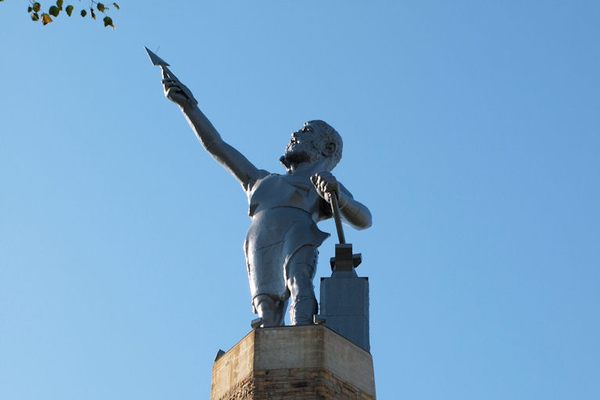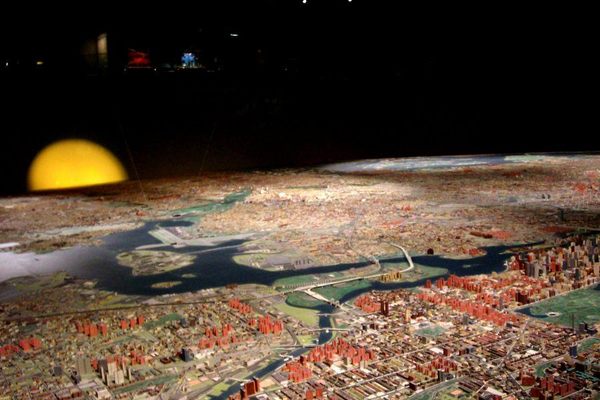Relics of the World’s Fair: St. Louis
Louisiana Purchase Festival Hall (via Wikimedia)
After visiting Paris, Chicago, Barcelona, New York City, and Montreal, Atlas Obscura’s tour of World’s Fair relics stops in St. Louis, Missouri.
The 1904 World’s Fair in St. Louis, otherwise known as the Louisiana Purchase Exposition, spanned 1,200 acres, boasted 1,500 buildings and 75 miles of roads and walkways, and included 62 foreign nations and 43 states in its exhibitions. Incredibly, though, only a few of those original buildings still stand — the rest were designed to be temporary structures, which were easier to construct and easier to dismantle.
The fair’s Palace of Fine Art now houses the Saint Louis Arts Museum. In 1904, the palace boasted a grand sculpture hall with a scale inspired by the recently-excavated Roman Baths of Caracalla in Italy.
The art museum at the fair in 1904 (via Amy Arch)
Saint Louis Art Museum (photograph by Chris Lawrence)
An administrative building for the fair also still exists. Now known as “Brookings Hall,” it’s home to administrative offices for Washington University.
Brookings Hall (photograph by grabadonut, via Flickr)
Elsewhere in St. Louis, visitors can find a third relic. The Smithsonian Institution in Washington, DC built a “Flight Cage” for the fair — a huge walk-through bird cage showcasing flocks of a variety of birds.
1904 Flight Cage (photograph by Robert Lawton)
The Smithsonian intended to dismantle the Flight Cage after the fair and bring it back to DC, but St. Louis citizens rallied to keep it. St. Louis bought the Cage outright a few years after the fair, and used the structure as the foundation for the Saint Louis Zoo.
Cypress Swamp Exhibit (photograph by Tom Bastin)
A fourth landmark now rests outside of St. Louis. As part of its exhibition in the fair, the city of Birmingham, Alabama, commissioned a mammoth statue in cast-iron to pay homage to its iron and steel industries. Italian artist Giuseppe Moretti designed a 56-foot statue of the Roman god Vulcan, holding a newly-forged spear in his right hand.
Vulcan (photograph by Alby Headrick)
However, the Vulcan statue suffered something of a spotty fate immediately following the fair. The statue had to be disassembled to load it onto the train back to Birmingham, but when the freight costs went unpaid, the pieces were unceremoniously dumped alongside the railroad tracks. Vulcan’s spear was lost along the way.
Birmingham civic leaders retrieved the pieces, but then spent over a year arguing about where to put the statue before finally placing it at the Alabama state fairgrounds. There the statue was occasionally pressed into service as an advertising tool, as local businesses paid to have the statue hold a sample of their product — an ice cream cone, a pickle, or the like in the hand that once wielded the spear. The statue also endured a few poorly-done paint jobs.
Vulcan Statue in Birmingham (photograph by David Gunnells)
Finally, Birmingham civic leaders proposed a restoration and relocation of the statue as a possible WPA project in the 1930s, and a team of artists renovated the statue while work crews cleared ground for a park on Red Mountain, just outside Birmingham. The statue was moved to the newly-created Vulcan Park in 1939, where it stands today.
Here are some more photographs from the grand 1904 Louisiana Purchase Exhibition:
photograph by David R. Francis
The Liberty Bell departing for the fair (via Library of Congress)
War Department Exhibit (via Wikimedia)
Battle Abbey (via Wikimedia)
Gateway to China (via Wikimedia)
The Illinois State Building and the Ferris wheel (via Wikimedia)
Grand Stairway of Cascade Garden (via Wikimedia)
Grand Basin (via Wikimedia)
Electricity Building (via Wikimedia)
Palace of Electricity (via Wikimedia)
Festival Hall (via Wikimedia)
“Bird’s Eye View” (via Wikimedia)
On the Pike (via Wikimedia)
Sunken Garden (via American Libraries)
Agricultural Building (via cosmorochester collects)
Geronimo at the fair (via Library of Congress)
Philippine village (via New York Public Library)
Recreation of the Battle of Paardeberg, Boer War (via New York Public Library)
Cairo (via New York Public Library)
Elephant “shooting the chutes” (via New York Public Library)
The swinging colonnade (via New York Public Library)
“Cairo” (via New York Public Library)
Biggest wheel on Earth (via New York Public Library)
Stay tuned for more in our series on World’s Fair relics, and be sure to visit Paris, Chicago, Barcelona, New York City, and Montreal.








Follow us on Twitter to get the latest on the world's hidden wonders.
Like us on Facebook to get the latest on the world's hidden wonders.
Follow us on Twitter Like us on Facebook